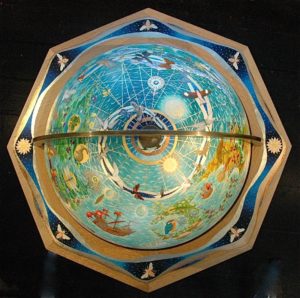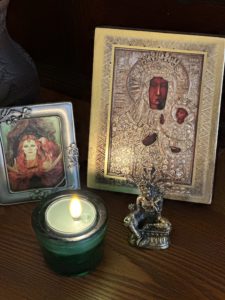Mother of Sorrows – the Universal Dark Mother
I was fascinated by my friend, Sr. Rita’s, take on Jesus’s mother, Mary, which she wrote about here.
Two things struck me most – first, her resistance to what she called the 1950s version of Mary: all pastels and rosy cheeks and purity so complete as to be bloodless; and second, her reminder that Mary, in her incarnation as Our Lady of Guadalupe is a reminder that: “The universal message of Guadalupe is to go to the poor, to be open to being evangelized by the poor, the oppressed, the broken, to hear and remedy their sorrows, laments, miseries, and pains not only in Mexico or Latin America but wherever oppressed people are found. Our Lady of Guadalupe calls us to commit to hear and to see the cry of the poor.”
Now, Sr. Rita calls herself “hopelessly Catholic,” and I respect that, even though I am not Catholic, hopelessly or otherwise. Many would say I’m not Christian, especially since I don’t believe in the idea that it is only through Jesus that I shall be ‘saved.’ However, unless I’m mistaken, Sr. Rita doesn’t believe that either. There are many paths to the Sacred, or whatever one calls the Mystery, in all cultures worldwide and I respect them all. I respect agnostics and most atheists (okay, maybe not those who are as fundamentalist and certain and proselytizing as the Taliban, but most). And I have my own experience of the Sacred, to which I am faithful. This experience involves the holy body of this planet, and the cosmos, and all creatures. I believe in Thich Nhat Hanh’s concept of “Interbeing.”

Fiona Owen — “Mundus Imaginalis” Gilded Globe (oil and gold leaf on gesso panel, 2012)
Part of my experience involves the mundus imaginalis, a term coined by the mystical Sufi scholar Henri Corbin and defined as: “a world that is ontologically as real as the world of the senses and that of the intellect. This world requires its own faculty of perception, namely, imaginative power, a faculty with a cognitive function, a noetic value as real as that of sense perception or intellectual intuition.” (Henri Corbin) I understand this to be, in part, where archetypes exist – mother, father, saviour, old woman, maiden, etc – independent of our perception of them. The Otherworld, in other words.
It is in this liminal space that I find Mary.
Mary appears to me as a universal figure of the female, the feminine, the mother, the maiden, and yes, the old woman as well. She has, I believe, been with all of us throughout every time period, including pre-Christian time. Indeed, like the Christ, I believe she resides beyond time and space. She is old, very old, constantly and consistently in contact with us, like the Christ, and she morphs into forms that are relatable to each of us, like the Christ. She is Gaia. Mother Earth. In Norse mythology, in her form as Our Lady of Sorrows, perhaps she is Freya, who weeps for her missing husband, and possibly Frigg, the mother goddess who intercedes with the father god on behalf of supplicant humans. She is Tonantzin Coatlicue (Our Mother Serpent Skirt), of the Aztecs, Cybele of the Greeks; the goddess Brighid of Ireland, who was later turned into a Catholic saint; she is a psychopomp: “pray for us sinners, now and at the hour of our death;’ she is Green Tara….
I’ve told this story elsewhere, but perhaps it’s also pertinent here. Some years ago, Joe Couture, a Cree elder, and ex-Jesuit priest said to me, “The archangel Michael and the Thunderbird? Same thing.” Yes! The Sacred/God is so much larger than we can perceive and certainly beyond the limits of our frail constructions. Mary and Tonantzin? Same thing.
As you can see, I would probably have been burned at the stake for heresy (and possibly witchcraft) once upon a time!
However, I’m delighted to report that Sr. Rita remains disinclined to put me to the torch.
One of the most important aspects of the figure of Mary is that she provides access to the feminine in what is otherwise a male-dominated religious landscape. Catholicism is the only one of the Christian denominations, as far as I know, that encourages veneration of Mary and through her, the Sacred Feminine.
Like many others, I had a complicated relationship with my mother, and so the Mary-as-Mother form repelled me for a long time. It reminded me of too much that was unsafe, untrustworthy, manipulative, and smothering. And yet at times, I caught glimmers of something emanating from her. Just there, at the corner of my eye.

Brigid, the Black Madonna, and Green Tara
It was during a period of agonizing depression that those glimmers turned into something more. I had always been fascinated by the Black Madonnas, found throughout the world, and suspected that if I were going to find a way to the Divine Feminine, it would be there. I began a practice of meditation and contemplation focused on The Dark Mother, and slowly but surely, a greater understanding of her and a greater experience of her began to grow. Here was a Spirit who understood profound, rib-cracking grief at the foot of the cross as she watched her beloved son die in unspeakable agony. Here was a Mother who loved fiercely, who widened her cloak and embraced all the pain of the world, all the sorrow, who embraced the sufferer, the one who grieves, and who walks with us, holding us until we can breathe again. Here was a Mother who, even in the moment of her own agony, accepted Jesus’s invitation to be mother to John.
Feel the grief, let it burn through you and turn to ash anything that will no longer serve you, anything now too heavy to carry, and then take the remaining, flame-purified love and let it flow out of you again. This was the message I found in the Universal Dark Mother, called Mary by many. And how grateful to her I am.
This is exquisite, Lauren. Nearly identical to my own experience and still muddled thinking. So beautifully expressed. Thank you,
Thank you, Jane. I’m so glad you liked it.
So happy you wrote this- well told!
Thanks, Rita! You know how much I love our conversations.
How fascinating! Your and Rita’s journeys show so well how there are many possible paths until one resonates and feels right for you, and for each one of us. Love the reference to “mundus imaginalis”.
Thanks to you and Sister Rita for these engaging posts. kind regards, Carin B.
Thanks Carin, and you’re very welcome!
Beautiful thoughts, Lauren. As you know, I am also fascinated by the Black Madonna – I’m still weaving her into my fiction! If more of us could take a step back, as you did in your depression and in this piece, and let the puzzle pieces come together, we might be more tolerant of each other.
Thanks, Linda! Your work with the Black Madonna, WHERE THE STORK FLIES is wonderful. Anyone reading this would do themselves a favor by reading it… https://www.amazon.com/Where-Stork-Flies-Linda-Wisniewski-ebook/product-reviews/B0933QKYQQ/ref=cm_cr_getr_d_paging_btm_next_4?ie=UTF8&reviewerType=all_reviews&pageNumber=4
Thank you, Lauren! Your support means so much!